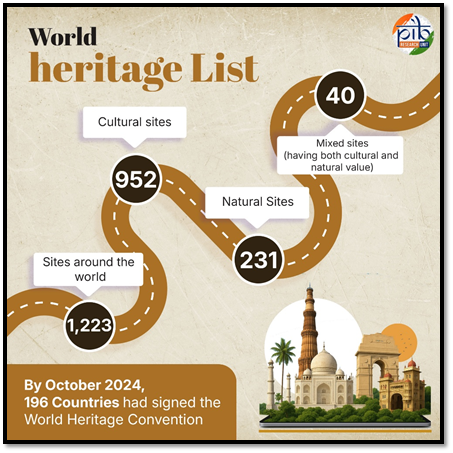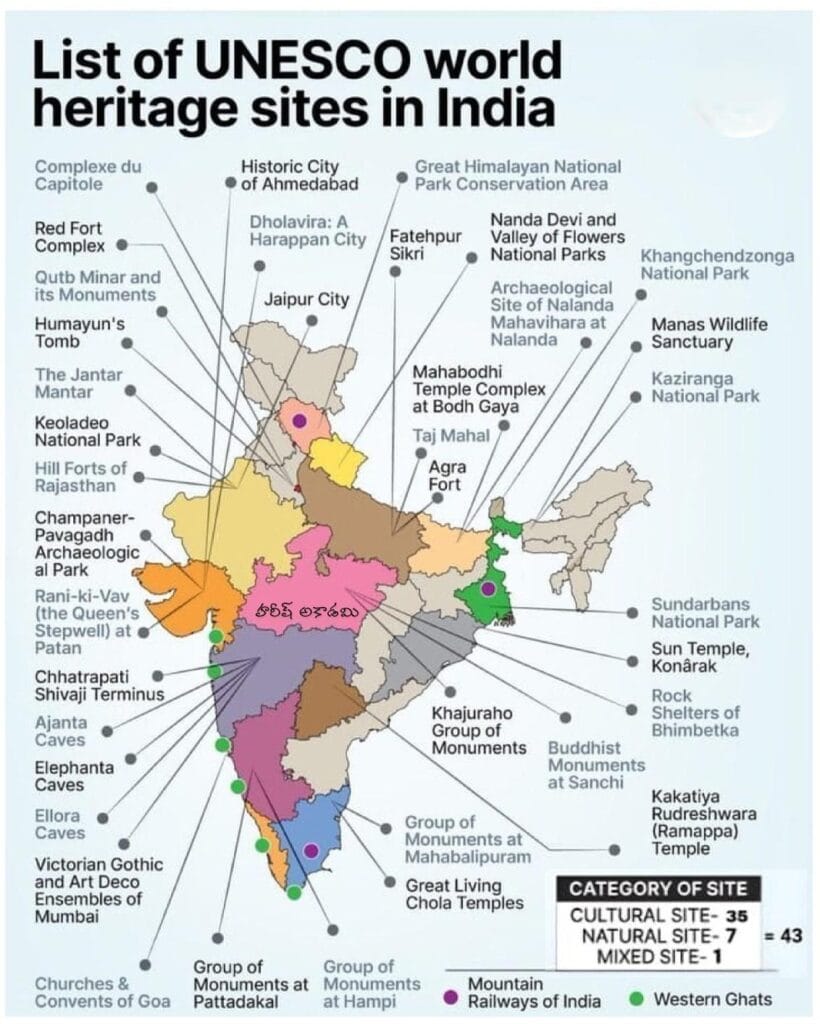World Heritage Day 2025
Introduction
On April 18, 2025, which is International Day for sites and Sites (World Heritage Day), the Archaeological Survey of India (ASI) announced that admission to its protected sites is free.
What is World Heritage Day?
- The reason of the around the world celebration is to raise mindfulness of the regard of social bequest and the require of its preservation. In 1982, the Widespread Board on Points of interest and Districts (ICOMOS) named it a point of interest, and in 1983, UNESCO certified it.
- The 2025 subject is “Planning and Learning from 60 Years A long time of ICOMOS Activities: Legacy beneath Danger from Fiascos and Clashes.”
Why World Heritage Day Celebrated?
- Raise Awareness
- It helps people understand the value of cultural heritage, how it shapes identity, and why it must be preserved for future generations.
- Promote Preservation
- Restoration of historical structures
- Protection of ancient ruins
- Maintenance of cultural landscapes and traditions
- Highlight Threats
- Climate change
- War and conflict
- Neglect or urban development
- Looting and vandalism
- Celebrate Diversity
- Heritage sites reflect the rich diversity of human history, from ancient temples to colonial architecture to sacred indigenous lands.
- Celebrating them fosters mutual respect and global unity.
- Educate and Inspire
- Events held on this day aim to educate the public, especially young people, about the importance of conservation and the stories behind historical places.
What are World Heritage Sites?
- Places designated as World Heritage Sites (WHS) are inscribed on the World Heritage List to be protected and preserved for future generations because of their exceptional global importance to mankind.
- These locations might be mixed-nature, cultural, or natural. The 1972 World Heritage Convention, an international pact ratified by UNESCO member nations, protects WHS.
- The obligations of State Parties in locating, safeguarding, and maintaining such places are delineated in the Convention.
- The international “World Heritage Programme,” which is run by the UNESCO World Heritage Committee, is responsible for maintaining the list of WHS.
- In 1977, India ratified the Convention.
How World Heritage Sites Are Selected?
- Tentative List
- A country first prepares a Tentative List of sites it might want to nominate.
- A site must be on this list before it can be officially considered.
- Nomination Dossier
- The country then prepares a Nomination File, which includes:
- Detailed descriptions
- Historical significance
- Maps and photos
- Management and protection plans
- The country then prepares a Nomination File, which includes:
- Evaluation
- ICOMOS – for cultural sites
- IUCN – for natural sites
- World Heritage Committee Decision
- The World Heritage Committee (21 countries) reviews all evaluations at their annual meeting.
- The committee can:
- Inscribe the site
- Refer it for more info
- Defer it for major revision
- Reject the nomination
What Makes World Heritage Site Eligible?
A site must meet at least one of the 10 criteria, such as:
- Cultural Criteria
- Represents a masterpiece of human creativity
- Shows an important exchange of cultures
- Is associated with events or traditions of universal significance
- Natural Criteria
- Has exceptional natural beauty
- Is an outstanding example of Earth’s history or ecosystems
- Supports rare or endangered species
What are Famous World Heritage Sites Around the World?
- The Great Wall of China: Stretching over 13,000 miles, this iconic structure is not just a feat of engineering but also a symbol of strength and resilience.
- The Pyramids of Egypt: These ancient marvels are a window into a civilization that has fascinated historians and travelers for centuries.
- The Historic Centre of Rome: From the Colosseum to the Roman Forum, this city is a living museum that showcases the grandeur of the Roman Empire.
- Machu Picchu in Peru: Hidden in the Andes, this Incan citadel is shrouded in mystery and surrounded by stunning natural beauty.
- Taj Mahal in India: A symbol of eternal love, the Taj Mahal is as famous for its breathtaking beauty as it is for its deep emotional story.
- WHS Around the World: There are about 1,223 sites in 196 nations as of October 2024, including 40 mixed, 231 natural, and 952 cultural sites.
- WHS in India: India has 62 sites on the Tentative List and 43 World Heritage Sites as of April 2025 (34 Cultural, 7 Natural, and 2 Mixed).
What are the Government Initiatives to Promote India’s Cultural Heritage Sites?
- Restoration of Antiquities: Since 1976, India has stepped up its attempts to recover cultural objects from other nations, recovering 655 antiques.
- Heritage Scheme and Corridor Projects: Public and corporate entities can assist cultural site maintenance through CSR money under the Adopt a cultural Program, which was introduced in 2017.
- Digital Documentation: Under the National Mission on Monuments and antiques (NMMA), 11,400 historic sites and more over 12.3 lakh antiques have been digitalized. The “Indian Heritage in Digital Space” project creates immersive historical experiences using technology.
- Global Cultural Leadership: The UNESCO World Heritage Committee’s 46th session was held in Delhi, India, in July 2024.
Conclusion
World Heritage Day 2025 celebrates global cultural richness while spotlighting urgent threats to heritage sites. With the theme “Legacy under Danger from Disasters and Conflicts,” it urges preservation through awareness, education, and action. Free entry to ASI sites emphasizes accessibility, inspiring citizens to value and protect history. Safeguarding heritage today ensures future generations can connect with humanity’s shared legacy.
Frequently Asked Questions (FAQs)
Are there World Heritage Sites in every country?
Not every country has one yet, but many have submitted nominations. Over 190 countries are part of the World Heritage Convention.
Can a site lose its World Heritage status?
Yes! If a site is not properly protected or loses the qualities for which it was listed, UNESCO can delist it. It’s rare—but it does happen.
What’s the difference between national and World Heritage Sites?
National heritage sites are recognized by a country’s own government, while World Heritage Sites are globally recognized by UNESCO.
What is the theme of World Heritage Day 2025?
Planning and Learning from 60 Years A long time of ICOMOS Activities
Sources:
- https://pib.gov.in/PressReleasePage.aspx?PRID=2122442#:~:text=The%20Archaeological%20Survey%20of%20India,explore%20India’s%20rich%20cultural%20heritage.
- https://www.moneycontrol.com/travel/world-heritage-day-2025-date-history-theme-and-significance-article-12995956.html
- https://www.ndtv.com/travel/world-heritage-day-2025-iconic-monuments-that-stood-the-test-of-time-8187251
- https://whc.unesco.org/en/events/1164/
- https://www.unesco.org/en/days
- https://www.indiatoday.in/information/story/world-heritage-day-2025-date-history-significance-and-all-you-need-to-know-2710904-2025-04-18


Leave a Reply